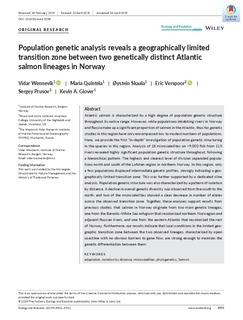| dc.description.abstract | Atlantic salmon is characterized by a high degree of population genetic structure throughout its native range. However, while populations inhabiting rivers in Norway and Russia make up a significant proportion of salmon in the Atlantic, thus far, genetic studies in this region have only encompassed low to modest numbers of populations. Here, we provide the first “in‐depth” investigation of population genetic structuring in the species in this region. Analysis of 18 microsatellites on >9,000 fish from 115 rivers revealed highly significant population genetic structure throughout, following a hierarchical pattern. The highest and clearest level of division separated populations north and south of the Lofoten region in northern Norway. In this region, only a few populations displayed intermediate genetic profiles, strongly indicating a geographically limited transition zone. This was further supported by a dedicated cline analysis. Population genetic structure was also characterized by a pattern of isolation by distance. A decline in overall genetic diversity was observed from the south to the north, and two of the microsatellites showed a clear decrease in number of alleles across the observed transition zone. Together, these analyses support results from previous studies, that salmon in Norway originate from two main genetic lineages, one from the Barents–White Sea refugium that recolonized northern Norwegian and adjacent Russian rivers, and one from the eastern Atlantic that recolonized the rest of Norway. Furthermore, our results indicate that local conditions in the limited geographic transition zone between the two observed lineages, characterized by open coastline with no obvious barriers to gene flow, are strong enough to maintain the genetic differentiation between them. | nb_NO |
